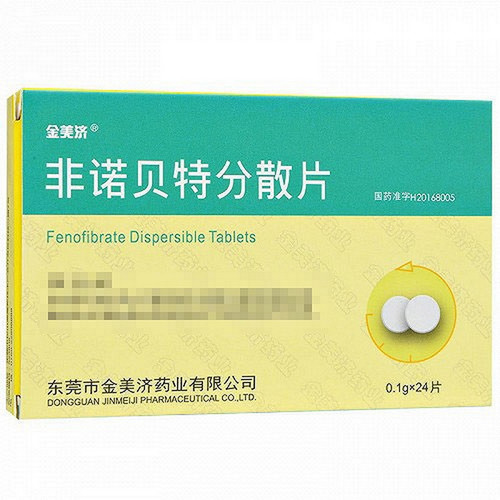Product Overview
[Drug Name]
Generic Name: Fenofibrate Dispersible Tablets
Trade Name: Jinmeiji Fenofibrate Dispersible Tablets 0.1g x 12 Tablets
[Main Ingredients]
The main ingredient of this product is fenofibrate.
[Indications/Main Functions]
For the treatment of hyperlipidemia in adults who have not responded well to dietary control therapy. It is more effective in lowering triglycerides and mixed hyperlipidemia than cholesterol.
[Specifications]
0.1g x 12 tablets
[Dosage and Administration]
Usual adult dosage: Oral, 0.2g (2 tablets) once daily. To reduce gastric discomfort, the tablet can be taken with food. The dosage should be reduced for patients with renal insufficiency and the elderly. Discontinue the drug if no effect is seen after two months of treatment.
[Contraindications]
1. Contraindicated in patients with allergies to fenofibrate. 2. Contraindicated in patients with a history of gallbladder disease or cholelithiasis. Fenofibrate dispersible tablets may increase the excretion of cholesterol into bile, which may cause gallstones. 3. This product is contraindicated in patients with severe renal insufficiency, hepatic insufficiency, primary biliary cirrhosis, or persistent liver dysfunction of unknown cause.
[Drug Interactions]
This product may enhance the efficacy of coumarin anticoagulants. Concomitant use may prolong the prothrombin time. Therefore, when used together, the oral anticoagulant dose should be reduced and subsequently adjusted based on test results. If this product is used in combination with bile acid-binding resins, such as cholestyramine, fenofibrate should be taken at least 1 hour before or 4-6 hours after these medications. Bile acid-binding drugs can also bind to other concurrent medications, potentially affecting their absorption. This product should be used with caution with HMG-CoA reductase inhibitors, such as pravastatin, fluvastatin, and simvastatin, as it may cause myopathy, including myalgia, rhabdomyolysis, and elevated blood creatine phosphokinase. In severe cases, the drug should be discontinued. Fenofibrate dispersible tablets are primarily excreted via the kidneys. When used concomitantly with immunosuppressants such as cyclosporine or other nephrotoxic drugs, there is a risk of worsening renal function. Therefore, the dose should be reduced or the drug should be discontinued.
[Precautions]
1. This product may interfere with diagnosis. Platelet count, blood urea nitrogen, aminotransferases, and serum calcium may increase; blood alkaline phosphatase, glutamyl transpeptidase, and bilirubin may decrease. 2. Regularly monitor the following during treatment: complete blood count and platelet count; liver function tests; blood cholesterol, triglycerides, or low-density lipoprotein cholesterol; and blood creatine phosphokinase. 3. If clinical symptoms suggestive of myopathy (such as myalgia, tenderness, fatigue) or a significant elevation in blood creatine phosphokinase are present, the drug should be discontinued. 4. While treating hyperlipidemia, it is also important to monitor and treat underlying conditions that may cause hyperlipidemia, such as hypothyroidism and diabetes. 5. Certain medications, such as estrogens, thiazide diuretics, and beta-blockers, can also cause hyperlipidemia. Once these medications are discontinued, corresponding anti-hyperlipidemic treatment is no longer necessary. 6. Dietary therapy remains the primary treatment for hyperlipidemia. Combined with exercise and weight loss, it is superior to any other medication. 7. Animal studies have shown that high doses (several times the maximum recommended human dose) of this product can cause carcinogenesis, teratogenesis, and mutagenesis. Related research in humans is not yet clear, and no reports of carcinogenicity or teratogenesis have been reported in clinical trials to date.
[Precautions]
1. This product may interfere with diagnosis. Platelet count, blood urea nitrogen, aminotransferases, and blood calcium may increase while taking this product; blood alkaline phosphatase, glutamyl transpeptidase, and bilirubin may decrease. 2. Regular monitoring during medication should include: complete blood count and platelet count; liver function tests; blood cholesterol, triglycerides, or low-density lipoprotein cholesterol; and blood creatine phosphokinase. 3. If clinical symptoms suggestive of myopathy (such as myalgia, tenderness, fatigue) or a significant elevation in blood creatine phosphokinase, discontinue the drug. 4. While treating hyperlipidemia, it is also important to monitor and treat underlying conditions that may cause hyperlipidemia, such as hypothyroidism and diabetes. 5. Certain medications, such as estrogens, thiazide diuretics, and beta-blockers, can also cause hyperlipidemia. After discontinuation of these medications, corresponding anti-hyperlipidemic treatment is no longer necessary. 6. Dietary therapy remains the primary treatment for hyperlipidemia. Combined with exercise and weight loss, it is superior to any other medication. 7. Animal studies have shown that high doses (equivalent to several times the maximum recommended human dose) of this drug can cause carcinogenesis, teratogenesis, and mutagenesis. Related studies in humans are not yet clear, and no reports of carcinogenesis or teratogenesis have been reported in clinical trials to date.
[Use in Elderly Patients]
The clearance of a single oral dose of this drug in elderly patients is similar to that in adults. However, if renal function is impaired, the dose should be appropriately reduced.
[Overdose]
Because fenofibrate is highly bound to plasma proteins, in the event of an overdose, hemodialysis should not be considered, and systemic supportive therapy should be implemented.
[Pharmacology and Toxicology]
Fenofibrate dispersible tablets are a biologic lipid-regulating drug similar to clofibric acid. They inhibit the production of very low-density lipoprotein (VLDL) and triglycerides and simultaneously increase their catabolism, thereby lowering blood LDL, cholesterol, and triglycerides. They also increase the production of apolipoproteins A1 and A11, thereby increasing high-density lipoprotein (HDL). This drug also has the effect of lowering serum uric acid in healthy individuals and patients with hyperuricemia. Animal experiments have shown that fenofibrate is teratogenic and carcinogenic.






